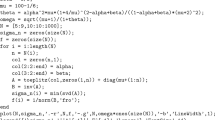Abstract
This note surveys recent strategies to estimate the condition number \(CN(T)=\Vert T\Vert \cdot \Vert T^{-1}\Vert \) of complex \(n\times n\) matrices T with given spectrum. More precisely, we present a proof of the fact that if T acts on the Hilbert space \(\mathbb {C}^{n}\), then the supremum of CN(T) over all contractions T with smallest eigenvalues of modulus \(r>0\), is equal to \(1/r^{n}\), and is achieved by an analytic Toeplitz matrix. The same question is treated for n-dimensional Banach spaces. These strategies provide with explicit and constructive solutions to the so-called Halmos and Schäffer’s problems, and are also shown to be effective in a closely related situation, namely considering Kreiss matrices instead of contractions.
Similar content being viewed by others
References
Andersson J.: Turán’s problem 10 revisited, preprint arXiv:math/0609271, (2008)
Andersson, J.: On some power sum problems of Turán and Erdös. Acta Math. Hungar. 70(4), 305–316 (1996)
Charpentier S., Fouchet K., Zarouf R.: Condition numbers of \(n\)-dimensional Banach space Kreiss operators (forthcoming)
Egervary, E.: Uber gewisse Extremumprobleme der Funktionentheorie. Math. Ann. 99, 542–561 (1928)
Erdös, P., Rényi, A.: A probabilistic approach to problems of Diophantine approximation, lllinois. J. Math. 1, 303–315 (1957)
Gluskin, E., Meyer, M., Pajor, A.: Zeros of analytic functions and norms of inverse matrices. Israel J. Math. 87, 225–242 (1994)
Horn, A.: On the eigenvalues of a matrix with prescribed singular values. Proc. Am. Math. Soc. 5, 4–7 (1954)
Hu, G.Y., O’Connell, R.F.: Analytical inversion of symmetric tridiagonal matrices. J. Phys. A: Math. Gen. 29, 1511–1513 (1996)
Montgomery, H.L.: Ten lectures on the interface between analytic number theory and harmonic analysis. AMS, Coll. CBMS Regional Conference Series in Mathematics, Vol. 84 (1994)
Nikolski N.: Private communication (2006)
Nikolski, N.: Condition numbers of large matrices and analytic capacities. St. Petersburg Math. J. 17, 641–682 (2006)
Nikolski, N.: Operators, Function, and Systems: an easy reading, vol. 1. Amer. Math. Soc, Monographs and Surveys (2002)
Nikolski, N.: Treatise on the Shift Operator, Springer, Berlin etc., 1986 (Transl. from Russian, Lekzii ob operatore sdviga, “Nauka”, Moskva, 1980)
Olkin, I., Peller, V.: Estimates of functions of power bounded operators on Hilbert spaces. J. Oper. Theory 7, 341–372 (1982)
Quarteroni, A., Sacco, R., Saleri, F.: Numerical Mathematics. Springer, Berlin (2000)
Queffélec, H.: Norm of the inverse of a matrix; solution to a problem of Schäffer, Harmonic Analysis from the Pichorides Viewpoint. Publications Mathématiques d’Orsay 68–87, (1995)
Queffélec, H.: Sur un théorème de Gluskin-Meyer-Pajor. C. R. Acad. Sci. Paris Sér. 1 Math. 317, 155–158 (1993)
Schäffer, J.J.: Norms and determinants of linear mappings. Math. Z. 118, 331–339 (1970)
Spijker, M.N.: Stability Estimates and Resolvent Conditions in the Numerical Solution of Initial Value Problems. Lecture Notes, Leiden (1998)
Szehr, O.: Eigenvalue estimates for the resolvent of a non-normal matrix. J. Spectr. Theory 4(4), 783–813 (2014)
Szehr, O., Zarouf, R.: Maximum of the resolvent over matrices with given spectrum. J. Funct. Anal. 272(2), 819–847 (2017)
Szehr O., Zarouf R.: A constructive approach to Schäffer’s conjecture, arXiv:1705.10704
Szehr O., Zarouf R.: Explicit counterexamples to Schäffer’s conjecture, submitted
Szehr O., Zarouf R.: Interpolation without commutants, forthcoming
Sz.-Nagy B., Foias C.: Harmonic Analysis of Operators on Hilbert Space, Translated from the French and revised, North-Holland Publishing Co., Amsterdam-London; American Elsevier Publishing Co., Inc., New York; Akadémiai Kiadó, Budapest, (1970)
Turán, P.: On a New Method of Analysis and its Applications. Pure and Applied Mathematics, New York (1984)
Vitse, P.: Functional calculus under Kreiss type conditions. Math. Nachr. 278(15), 1811–1822 (2005)
Zarouf, R.: Toeplitz condition numbers as an \(H^{\infty }\) interpolation problem. J. Math. Sci. 156(5), 819–823 (2009)
Acknowledgements
The authors are grateful to the referee whose numerous suggestions have improved both the manuscript and its presentation.
Author information
Authors and Affiliations
Corresponding author
Ethics declarations
Conflict of interest
The authors declare that they have no conflict of interest.
Additional information
Publisher's Note
Springer Nature remains neutral with regard to jurisdictional claims in published maps and institutional affiliations.
The first author is partly supported by the Grant ANR-17-CE40-0021 of the French National Research Agency ANR (Project Front). The last author is supported by Russian Science Foundation Grant 14-41-00010.
Appendix: Proof of Lemma 3.1
Appendix: Proof of Lemma 3.1
We prove Lemma 3.1. Clearly, since J is an isometry, X and \(\widetilde{X}\) have the same norm. In order to find the largest eigenvalue of \(\widetilde{X}\), upon writing \(\det (\widetilde{X}^{2}-z^{2})=\det (\widetilde{X}-z)\det (\widetilde{X}+z)\), we notice that it is enough to look for the largest eigenvalue of \(\widetilde{X}^{2}\). Let us then search for the solution \(z^{2}\) of \(\det (\widetilde{X}^{2}-z^{2})=0\). Denoting by \(C_{1},C_{2},\dots ,C_{n}\) the n columns of the matrix \(\widetilde{X}^{2}-z^{2}\), and by \(C_j(i)\) the i-th entry of \(C_j\), we find
where the term \(-z^{2}+\beta ^{2}\xi ^{2j-2}(1+\xi ^{2}+\cdots +\xi ^{2(n-j-1)})+\xi ^{2n-2}\) appears at line j. Note also that the sum \(1+\xi ^2+\cdots +\xi ^{2(n-j-1)}\) is empty if \(j=n\).
Then, in order to reduce \(\det (\widetilde{X}^{2}-z^{2})\), we follow the three following steps:
(1) We divide the kth-column by \(\xi ^{k-1}\) and the kth-row of \((\widetilde{X}^{2}-z^{2})\) by \(\xi ^{k-1}\).
(2) To the determinant obtained in (1), we substract the \(k^{th}\)-column from \((k-1)\)th-one and leave the \(n^{th}\)-one unchanged. E.g. for \(n=5\) we obtain the determinant
(3) To the determinant obtained in (2), we substract the \((k-1)^{th}\)-row from the \(k^{th}\)-one and leave the \(n^{th}\)-one unchanged. At the end of this step, we obtain the determinant of a tridiagonal \(n\times n\) matrix.
(4) In the determinant obtained in (3), we mutiply the \(k^{th}\)-row by \(\frac{\xi ^{2k-1}}{z^{2}}\). At the end of this step, we obtain again the determinant of a tridiagonal matrix \(n\times n\) matrix, which we will denote by A:
where \(\gamma \) and y are defined as in the statement of the lemma and where
Thus one can get
which completes the proof of the lemma, setting \(\mu =\frac{\alpha }{\xi }\).
Rights and permissions
About this article
Cite this article
Charpentier, S., Fouchet, K., Szehr, O. et al. Condition numbers of matrices with given spectrum. Anal.Math.Phys. 9, 971–990 (2019). https://doi.org/10.1007/s13324-019-00328-4
Received:
Revised:
Accepted:
Published:
Issue Date:
DOI: https://doi.org/10.1007/s13324-019-00328-4




